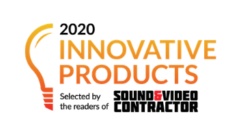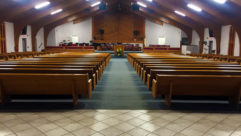Live Music and Music Reproduction in houses of worship
May 1, 1998 12:00 PM
Sound systems in houses of worship are necessary for two basicreasons-everyone needs to hear the spoken word clearly, and everyone needsto experience the musical portion of the program. The complexity of systemdesign in houses of worship can be quite vast, as there are numerous typesand sizes of facilities and gatherings. The following are some things toconsider when choosing application-specific sound equipment.
When making equipment choices, it is first necessary to assess the type ofprogram material that the system will reinforce. All houses of worship needto produce the spoken word, making the need for a highly intelligiblesystem a priority. Just as important in most systems is the need toreinforce live music and play back recorded music. The criteria for meetingall these needs affects many aspects of the system design and installation.
Horns vs. cones It has often been repeated that cone loudspeakers in thecritical midrange frequencies (where the vocal range resides) sound lessharsh to the ear than horns coupled to compression drivers. This is, ofcourse, a subjective observation, and many factors, such as roomreflections, architectural features, size, and positioning of the system inthe space, all come into play when determining the loudspeaker systemultimately suited for the application. Through the careful selection ofwell-designed horns, the system designer can concentrate the vocal range offrequencies within the seating area. This results in less energy beingreflected off of walls, thereby enhancing intelligibility. Nothing beats ahorn for sheer output power and controlling dispersional characteristics,yet a cone midrange is often smoother sounding and more musical. Because oftheir lower per-unit output, though, additional cone midrange loudspeakersmay be needed, increasing overall system expense. One important factor inchoosing is to determine just how loud the system needs to be to provideuniform coverage to all the seats in the facility, being careful to chartthe coverage angles of the system and make sure that all seats fall withinthe coverage area. Computer modeling systems can be quite helpful in thisarea, although determining placement is also based on previous experiencein similar types of rooms. It is important to note that, for a givenloudspeaker efficiency, in order to raise the system output level by 3 dB,it will be necessary to double the acoustical (and consequently theelectrical) value of the system. Due to limited budgets, it is more ofteneconomics that determines the resulting system design.
The days when a congregation might have been satisfied with a voice-onlysystem that featured rolled-off highs and lows are long gone. Theexpectations of today’s congregation members are set by the linear,extended response of high-quality, digital media heard daily at home, inthe car and at the theater. Worship services these days can rivalprofessional concerts in musical instrumentation and output, and they willtax an inadequately designed low-frequency section of the sound system. Inthese cases, the people listening want to be “moved by the bass,” and forthat effect, there is no substitute for large woofers. There are manyone-box system solutions available from many reputable loudspeaker systemmanufacturers, and most offer additional low-frequency cabinets to add tothe low end, if needed.
The console The mixing console is the heart of all signal control in thesound system. Care must be taken when planning a purchase to guaranteethat the mixer will have all the necessary features for the givenapplication. For multiple musical instrument inputs, access to monitormixes and the ability to distribute effects across different channels, thechoice is a mixer designed specifically for live sound reinforcement.
In general terms, live music consoles must provide adequate EQ on eachinput channel, as well as monitor mixing capability, effects send/returnoptions and decent signal metering. The cost-per-input has droppeddramatically in recent years, and most congregations would be wise topurchase more console than they currently need. Extra inputs quickly becomerequired inputs for special events and for accommodating growth in themusic ministry. Automation features, such as group or scene muting, aregreat time savers and allow some pre-programming of the console for ease ofuse. These features not only simplify operation each week, but they canalso be a lifesaver when the system is used for more complex applications,such as dramas and concerts. It seems as though you can never have enoughfeatures or inputs, so it is wise to maximize the budget when it comes tothe live sound mixer.
Feedback and filters The mixer provides EQ on each channel that is quiteuseful, but at times, those operating the console rely too heavily on it.Rather than adjusting the EQ on the console channel, sometimes all that isnecessary is better mic selection or placement. In other words, do not useEQ as the solution for all problems; consider improving mic placementfirst. Keep in mind that feedback can become a problem because of micplacement. The closer the mic is to the sound source, the less a mic levelneeds to be boosted to deliver adequate sound pressure level (SPL) to thelistener. The potential for feedback always exists whenever distant micingis attempted in sound reinforcement. The least expensive solution forfeedback is always to decrease the distance between the sound source andthe mic. By necessity, most houses of worship use a combination of closemic techniques and distant micing.
Subtractive EQ Program EQ is used to compensate for non-linearities in thesystem’s frequency response so that specific frequencies will be neitherover- nor under-emphasized. The result is improved gain-before-feedback,higher intelligibility and reduced listener fatigue. The concept ofsubtractive EQ is simple: reduce the frequencies that are offending, ratherthan boost those that are lower in the mix. This is most often done with agraphic EQ, but sometimes a parametric EQ may be used to provide a moreprecise correction of response problems. Subtractive EQ generally resultsin lower noise and greater headroom than that obtained by boosting somefrequencies while attenuating others. Although some mixers have smallgraphic EQs on board as an output feature, a separate 1/3-octave graphic EQwill provide a wider range of frequencies and usually a greater level ofcontrol. No input channel strip EQ will substitute for an outboard EQ inthis application.
Placement of the mixing position Often overlooked when designing a systemfor houses of worship is the location of the mixing position. The task ofthe system operator, at the very least, is to insure that levels aremaintained within a comfortable range, that various sources are combined atappropriate relative levels and that distracting noises or annoyingresponse abnormalities are avoided. It is imperative, then, that the mixingconsole be placed where the operator hears what the congregation hears. Aproperly designed system should provide uniform sound coverage throughoutthe seating area, allowing for some freedom in making the placementdecision. If aesthetics are a chief concern, then the mixer is sometimesplaced in a location in which it is difficult or impossible to operate itwhile hearing the system as the audience does. In such situations, thedistractions caused by a poor mix will almost always be greater than thosecreated by locating a mixer within the worship space.










